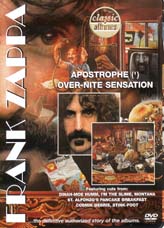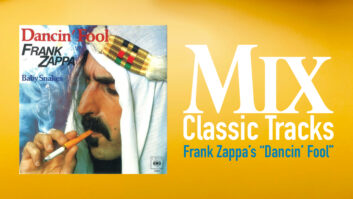
Frank Zappa: Apostrophe and Over-Nite Sensation
(Eagle Vision)
For my money, Eagle Vision’s ongoing series of “Classic Albums” DVDs is the greatest single source of detailed, insightful historical rock documentaries on the market. Over the years they’ve tackled a really wide variety of bands, from Metallica to the Grateful Dead, and every one I’ve seen has been entertaining and highly informative. This isn’t the jive Behind the Music approach of cataloging and sensationalizing artists’ ups and downs and magnifying their peccadillos. No, these docs are truly behind the music-examining how great albums were recorded, what inspired the songs, and how the musicians worked together to create fantastic music. The latest in the series, on two Frank Zappa albums from the early ’70s, is a great case in point.
First of all, kudos are in order for even picking Zappa for “Classic Albums,” as he was not exactly a chart-busting artist. But Zappa was unquestionably one of rock’s most fascinating and compelling figures, and they’ve chosen a perfect combo of albums: Over-Nite Sensation (1973) and Apostrophe (1974)-that really showcase what he did best…which is really hard to describe to the uninitiated. He actually did sell records from time to time, too-both of these albums went Gold, amazingly enough.
Zappa was a truly idiosyncratic artist with incredibly varied influences-everything from ’50s rock and doo-wop to jazz to modern composers like Varese and Stockhausen-and his albums reflected his deep passion for all of those styles and more. Both with his group the Mothers of Invention and on a zillion solo albums (the guy was seriously prolific) he carved out his own niche-just call it Zappa Music. He could play amazing psychedelic guitar solos-yet he mocked the drug culture and the bands that came out of it. But then, he mocked nearly everything. As one of rock’s great satirical provocateurs, he was constantly needling the government, the counterculture, commercialism; you name it. He was often sexual and scatological and often just downright silly. But the music! What an inspired polyglot he created; what a fearless composer, so willing to meld different styles and textures in such unusual ways to serve his muse.
Though just over 45 minutes (plus lots of great bonus material), the Zappa “Classic Albums” documentary goes a long way toward explaining the composer’s peculiar genius. Though Zappa himself died of prostate cancer in 1993, the story is told through contemporary interviews with some of the amazing musicians who worked on the albums-including keyboardist George Duke, drummer Ralph Humphrey, percussionist Ruth Underwood (a master of marimbas and vibraphones), reeds player/multi-instrumentalist Ian Underwood, saxophonist Napoleon Murphy Brock-various friends and associates, from Alice Cooper to Billy Bob Thornton, and family members: wife Gail, daughter Moon, and most prominently, son Dweezil, himself a fine musician who has helped keep his dad’s legacy alive in part by touring with a group devoted to Frank’s music (Zappa Plays Zappa). All speak of Frank with both admiration and affection, and in Dweezil’s case, he is often shown at a console, breaking down the tracks on the album, clearly illustrating how Frank would combine instruments in cool ways for unison passages, create interesting harmonies by constructing his own chords, layer effected vocals, use unique counter-rhythms…all in the service of something only he could see before it was stitched together.
There is lots of footage of the band performing parts of several different songs live, as well as a generous amount of vintage interview material of the bright and talkative Zappa expounding upon his approach to music. Further, Dweezil demonstrates some particulars of Frank’s style on guitar, and Ruth Underwood gives a fascinating marimba demonstration to explain an aspect of Zappa’s compositional technique. Among the songs that get partially dissected are “I’m the Slime,” “Dinah-Moe Hum,” “Montana,” “Stink-Foot,” “St. Alfonzo’s Pankcake Breakfast” and “Cosmik Debris.” Did you know that Tina Turner and two other members of the Ikettes sang on “Zombie Woof”? I didn’t, but Dweezil isolates their track for us and then shows us how it fits into the whole of what is a very weird song. On another tune he shows us how Frank multed a horn and violin part on a single track to make a singular sound.
George Duke, who has gone on to a long, illustrious career on his own since his Zappa days, describes how hard the band worked, rehearsing hour after hour and recording constantly—Zappa may very well have recorded more music in the studio than any other “popular music” (and I use that term very loosely) artist. When someone played in Zappa’s band, he says, “This was a serious commitment-a commitment to excellence.”
Bonus features on the disc include live performances of “Montana” from the Roxy in L.A. in 1973, “I’m the Slime” from a 1976 Saturday Night Live, Zappa Plays Zappa tackling “Camarillo Brillo” in 2006, and lots more explication from Dweezil and others about the Frank’s music and the way he recorded. All in all it’s a wonderful portrait of a true eccentric, whose music will no doubt continue to thrill and baffle music fans for generations to come.
Comments? Questions? Suggestions? You can reach me at [email protected]. Remember, in the immortal words of FZ, “Don’t Eat the Yellow Snow!”







